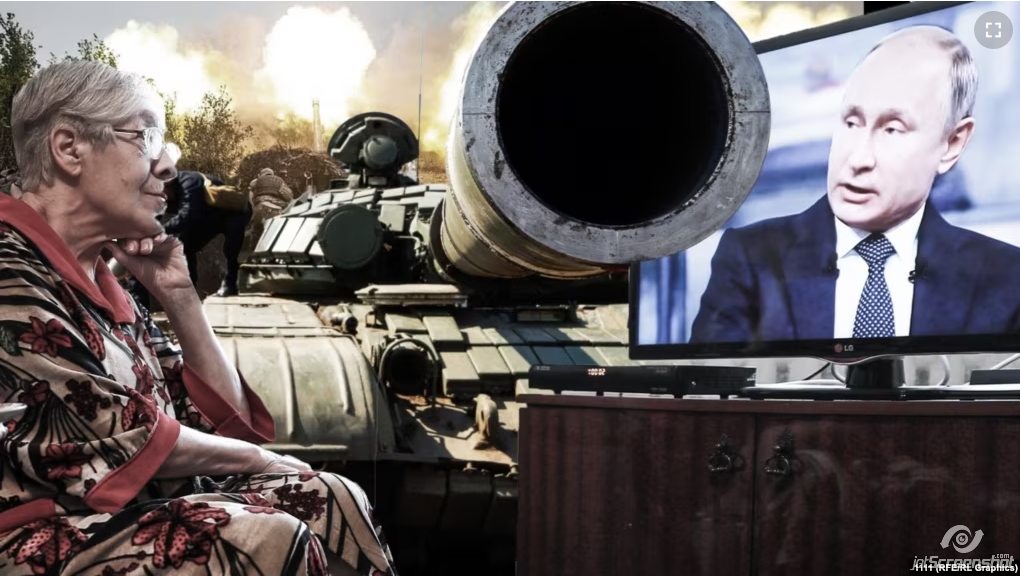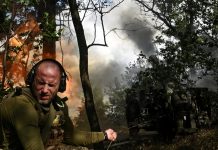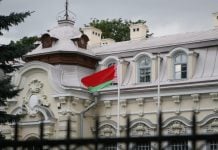By Ksenia Lirillova, for Jamestown Foundation
The consequences of Moscow’s war against Ukraine have begun to appear in Russian territory. At the end of February 2023, Russia’s border regions suffered a massive drone attack. On February 27, four drones crashed or were shot down in the Belgorod and Bryansk regions. On the night of February 28, a drone strike caused an explosion at an oil depot in Tuapse, and two more were downed in the Republic of Adygea and Moscow region (BBC News Russian, February 28).
On March 2, tragedy struck again in Bryansk Oblast. Several attackers openly fired into moving cars resulting in the deaths of two men and the wounding of a 10-year-old boy. The so-called “Russian Volunteer Corps,” headed by ultraconservative Russian Denis Nikitin, claimed responsibility for the attack (Telegraf.com.ua, March 2). The General Staff of the Ukrainian Armed Forces and advisor to the Office of the President of Ukraine, Mikhail Podolyak, called the incident a “Kremlin provocation” and denied any Ukrainian involvement. Podolyak further advised the Russian authorities to “fear their own partisans” (Liga.net, March 2).
At the same time, all official Russian channels, including the leadership of the Russian Federal Security Service (FSB), characterized the shooting as an “act of terror by Ukrainian saboteurs” (1tv.ru, March 3). The Kremlin’s unwillingness, even theoretically, to admit that partisans from among the Russian citizenry could operate within Russian territory and that the security services are having trouble identifying such factions is understandable. This version not only discredits the police and the FSB, but it also destroys the myth that supposedly almost the entire Russian population unanimously supports the war.
Furthermore, the official version is unflattering for the Russian army and special services, which are apparently incapable of securing the state border. Even media loyal to the Kremlin note that the fact that the group’s entry and exit from Russian territory went undiscovered “speaks either of criminal negligence … or of abetting the crime. … In any case, it has shown that the border with Ukraine is porous” (Pravda.ru, March 3).
Regardless of the Russian authorities’ increasing helplessness in protecting the population from the consequences of the war they unleashed, Kremlin propaganda is trying to wrest maximum benefit from the situation, yet again presenting the conflict in Ukraine as a defensive war. Even shortly before its re-invasion in February 2022, the Kremlin had tried to portray its aggressive war as “self-defense.” In the first weeks of the all-out war, Moscow cited numerous theories about an alleged attack by the West and Ukraine being “averted” (see EDM, March 1, 2022). And later, propagandists began citing a non-existent “attack on Russia” as a fait accompli.
It is quite telling that, last year, in a conversation with now-deceased Darya Dugina, Russian propagandist Nikolay Rosov postulated: “How wonderful it would be if we had not launched a special operation, and Ukraine would really have attacked us.” By his remarks, Rosov did not hide the fact that, in such a case, it would have been much easier to mobilize Russians for war (YouTube, August 22, 2022).
Versions of what constituted this alleged attack are rather bizarre. Some propagandists claim that it happened several decades ago, and since then, Russia has been under the West’s neo-colonial yoke (see EDM, February 22, 2022). However, most frequently, Kremlin propaganda does not even specify who “attacked Russia” and when it took place, instead coming up with numerous explanations for why it happened. The most popular version from pro-Kremlin “experts” in this regard is the theory that the United States “cannot accept the loss of its hegemonic position” and that Russia was somehow a convenient target for aggression (YouTube, February 25).
The blurring of Russia’s present-day borders is yet another means for Moscow in presenting its war as defensive. Some experts have often noted that one of the main results of the war was the actual transformation of Russia into a “failed state.” And borders of this state were not recognized internationally and were unclear even for the Russians themselves, as they constantly change depending on the situation on the battlefield (YouTube, February 23).
However, even these circumstances, which would be extremely dangerous for any state, seem to benefit Russian President Vladimir Putin, as it confirms his own thesis that “Russia’s borders do not end anywhere” (BBC News Russian, November 24, 2016). This permits him to declare that any attempt to dislodge Russian occupiers from a particular territory is a “defensive war.” For example, recently, the Russian Foreign Ministry stated that any threat to Russian peacekeepers and military depots in Transnistria would be considered “an attack on the Russian Federation” (Mid.ru, February 24).
Nevertheless, practice shows that such tricks, though they help to maintain passive popular support for the war, do not lead to effective mobilization. The only factor that led to some people who previously held dissident joining the Russian Armed Forces was the shelling of Belgorod and the realization that “war could come to our house” (see EDM, November 1, 2022).
Keeping this in mind, Russian propaganda is trying to make the most of the Bryansk attack by drawing the population deeper into a so-called “people’s war.” The media compares the incursion to the hostage-taking of terrorists in schools and hospitals, evoking associations with Chechen field commanders and a sense of fear and instability deeply rooted in memories of the 1990s (Business-gazeta.ru, March 2).
Against this backdrop, a wide range of speakers, ranging from Ramzan Kadyrov to military correspondents and members of the presidential “Council for Human Rights,” are calling for devastating “retaliation strikes” against Ukraine (Fedpress.ru, March 2). The border guards, in turn, declare the need to involve “people’s squads” in protecting the borders, as the FSB is lacking personnel for this mission (Mk.ru, March 2). The creation of such squads would mean the deeper involvement of Russian civilians in the war.
Yet another example of Russian propagandists using tragedy to drum up public support for the war is the effort to create a cult figure out of the boy, Fyodor, who, even after being wounded in the attack, helped the two girls he was with make it to safety. Propagandists emphasize that the child was wounded with “NATO weapons,” creating high-profile headlines, such as “A NATO Bullet in a Russian Child’s Back” (Tsargrad.tv, March 3). Many media outlets compare him with Soviet “hero-pioneers” and reprint the story that Fyodor’s older brother “is in the zone of the special military operation,” underscoring that he belongs to a “patriotic family” (News.ru, March 4). They even gave Fyodor a medal “For Courage” and dedicated verses to him, which resembles the cult of “hero-pioneers” in Soviet schools (Eadaily.com, March 3).
It is entirely possible that such an approach could lead to a limited mobilizing effect. However, even pro-Kremlin sociologists note that, together with the preservation of formal support for the war, demands for peace talks are growing in Russian society (Tgstat.ru, March 3). Support for Putin’s war in Russia is largely determined by the persistence of the illusion of a peaceful life, and the destruction of this illusion inevitably will affect the authorities’ public standing.
By Ksenia Lirillova, for Jamestown Foundation





